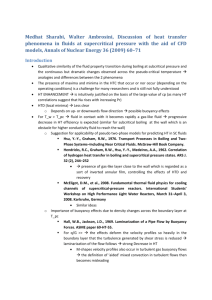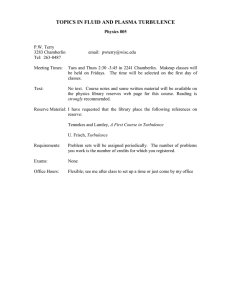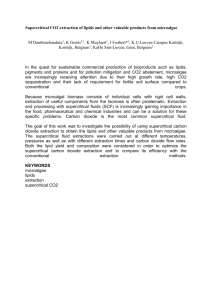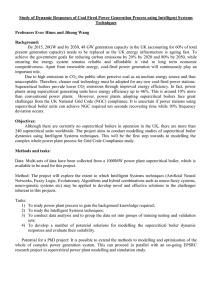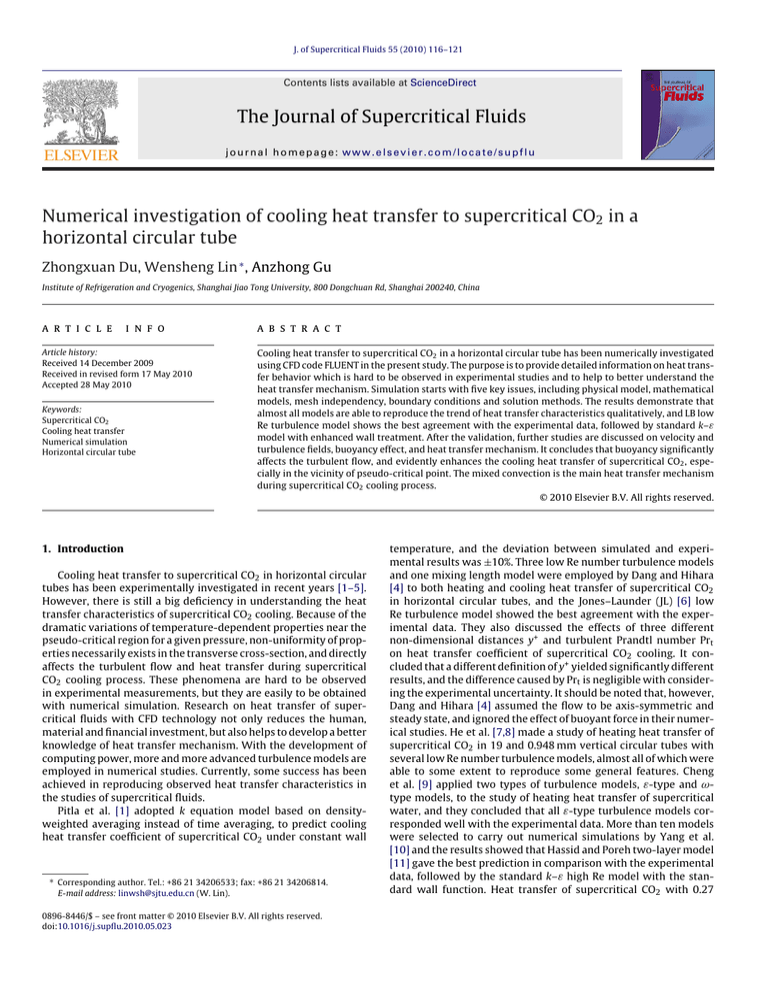
J. of Supercritical Fluids 55 (2010) 116–121
Contents lists available at ScienceDirect
The Journal of Supercritical Fluids
journal homepage: www.elsevier.com/locate/supflu
Numerical investigation of cooling heat transfer to supercritical CO2 in a
horizontal circular tube
Zhongxuan Du, Wensheng Lin ∗ , Anzhong Gu
Institute of Refrigeration and Cryogenics, Shanghai Jiao Tong University, 800 Dongchuan Rd, Shanghai 200240, China
a r t i c l e
i n f o
Article history:
Received 14 December 2009
Received in revised form 17 May 2010
Accepted 28 May 2010
Keywords:
Supercritical CO2
Cooling heat transfer
Numerical simulation
Horizontal circular tube
a b s t r a c t
Cooling heat transfer to supercritical CO2 in a horizontal circular tube has been numerically investigated
using CFD code FLUENT in the present study. The purpose is to provide detailed information on heat transfer behavior which is hard to be observed in experimental studies and to help to better understand the
heat transfer mechanism. Simulation starts with five key issues, including physical model, mathematical
models, mesh independency, boundary conditions and solution methods. The results demonstrate that
almost all models are able to reproduce the trend of heat transfer characteristics qualitatively, and LB low
Re turbulence model shows the best agreement with the experimental data, followed by standard k–ε
model with enhanced wall treatment. After the validation, further studies are discussed on velocity and
turbulence fields, buoyancy effect, and heat transfer mechanism. It concludes that buoyancy significantly
affects the turbulent flow, and evidently enhances the cooling heat transfer of supercritical CO2 , especially in the vicinity of pseudo-critical point. The mixed convection is the main heat transfer mechanism
during supercritical CO2 cooling process.
© 2010 Elsevier B.V. All rights reserved.
1. Introduction
Cooling heat transfer to supercritical CO2 in horizontal circular
tubes has been experimentally investigated in recent years [1–5].
However, there is still a big deficiency in understanding the heat
transfer characteristics of supercritical CO2 cooling. Because of the
dramatic variations of temperature-dependent properties near the
pseudo-critical region for a given pressure, non-uniformity of properties necessarily exists in the transverse cross-section, and directly
affects the turbulent flow and heat transfer during supercritical
CO2 cooling process. These phenomena are hard to be observed
in experimental measurements, but they are easily to be obtained
with numerical simulation. Research on heat transfer of supercritical fluids with CFD technology not only reduces the human,
material and financial investment, but also helps to develop a better
knowledge of heat transfer mechanism. With the development of
computing power, more and more advanced turbulence models are
employed in numerical studies. Currently, some success has been
achieved in reproducing observed heat transfer characteristics in
the studies of supercritical fluids.
Pitla et al. [1] adopted k equation model based on densityweighted averaging instead of time averaging, to predict cooling
heat transfer coefficient of supercritical CO2 under constant wall
∗ Corresponding author. Tel.: +86 21 34206533; fax: +86 21 34206814.
E-mail address: linwsh@sjtu.edu.cn (W. Lin).
0896-8446/$ – see front matter © 2010 Elsevier B.V. All rights reserved.
doi:10.1016/j.supflu.2010.05.023
temperature, and the deviation between simulated and experimental results was ±10%. Three low Re number turbulence models
and one mixing length model were employed by Dang and Hihara
[4] to both heating and cooling heat transfer of supercritical CO2
in horizontal circular tubes, and the Jones–Launder (JL) [6] low
Re turbulence model showed the best agreement with the experimental data. They also discussed the effects of three different
non-dimensional distances y+ and turbulent Prandtl number Prt
on heat transfer coefficient of supercritical CO2 cooling. It concluded that a different definition of y+ yielded significantly different
results, and the difference caused by Prt is negligible with considering the experimental uncertainty. It should be noted that, however,
Dang and Hihara [4] assumed the flow to be axis-symmetric and
steady state, and ignored the effect of buoyant force in their numerical studies. He et al. [7,8] made a study of heating heat transfer of
supercritical CO2 in 19 and 0.948 mm vertical circular tubes with
several low Re number turbulence models, almost all of which were
able to some extent to reproduce some general features. Cheng
et al. [9] applied two types of turbulence models, ε-type and ωtype models, to the study of heating heat transfer of supercritical
water, and they concluded that all ε-type turbulence models corresponded well with the experimental data. More than ten models
were selected to carry out numerical simulations by Yang et al.
[10] and the results showed that Hassid and Poreh two-layer model
[11] gave the best prediction in comparison with the experimental
data, followed by the standard k–ε high Re model with the standard wall function. Heat transfer of supercritical CO2 with 0.27
Z. Du et al. / J. of Supercritical Fluids 55 (2010) 116–121
117
Nomenclature
A
cp
d
g
Gr
h
k
m
Nu
p
Pr
q
Re
T
v
surface area, m2
specific heat, J kg−1 K−1
tube diameter, m
gravity acceleration, 9.81 m s−2
Grashof number, [g˛Td3 /2 ]
heat transfer coefficient, W m−2 K−1
thermal conductivity, W m−1 K−1
mass flux, kg m−2
Nusselt number [hd/k]
pressure, Pa
Prandtl number [cp /k]
heat flux, W m−2
Reynolds number [md/]
temperature, K
velocity, m s−1
Fig. 1. Physical model.
2D axis-symmetric model. The inner diameter of the tube in the
present study is 6 mm. The physical model as showed in Fig. 1 is
established in FLUENT preprocessor GAMBIT [18].
2.2. Mathematical models
Greek symbols
˛
volume expansivity, T−1
dynamic viscosity, Pa s
Subscripts
b
bulk fluid
D
Dittus–Boelter correlation
w
wall
0
inlet state
and 2 mm circular tubes in upward flow was investigated experimentally and numerically for laminar, transition and turbulence
flow by Jiang et al. [12–14]. They made the conclusion that different models performed well at different conditions. Sharabi et al.
[15] conducted computational simulations of turbulent convective
heat transfer to supercritical CO2 in square and triangular channels. The results obtained using the low Re number models were
able to reproduce the trend of heat transfer deterioration due to
buoyancy influence, but with a relatively large overestimation of
measured wall temperatures. Shang et al. [16] extended previous
researches on buoyancy effect by further investigating the coupling
effects of the pressure and buoyancy with Speziale quadratic high
Re k–ε turbulence model.
In spite of a number of numerical works, there is no generalized model to predict heat transfer coefficient of supercritical
fluids. Moreover, the existing numerical study in the open literature
mainly focused on heating heat transfer of supercritical CO2 and
water in vertical tubes, and only a few numerical papers referred
to supercritical CO2 cooling in turbulence flow. The present study
is aimed at evaluating the performance of a number of turbulence
models using FLUENT [17] code to predict cooling heat transfer
coefficient of supercritical CO2 in a horizontal circular tube. Then,
detailed studies on velocity and turbulence fields, buoyancy effect
and heat transfer mechanism are discussed.
2. Numerical modeling
2.1. Physical model
Due to the sharp variations of density with temperature in the
vicinity of the pseudo-critical point, strong buoyancy will be definitely produced during supercritical CO2 cooling process. Different
from the fluid flow in vertical circular tubes, the combined effect of
gravity and buoyancy in horizontal circular tubes leads to asymmetric of velocity and temperature. Consequently, the physical
model should remain a 3D one instead of being simplified to a
Selection of turbulence model plays an important role in numerical simulation. Although many numerical studies have been done
mentioned above, there is not yet a universal model for predicting heat transfer coefficient of supercritical fluids. The models that
provided good predictions in relation to heat transfer under heating conditions will be adopted for studying cooling heat transfer to
supercritical CO2 in the present work, including standard k–ε, RNG
k–ε, Reynolds stress model (RSM) and six low Reynolds turbulence
models: Abid (AB) [19], Lam–Bremhorst (LB) [20], Launder–Sharma
(LS) [21], Yang–Shih (YS) [22], Abe–Kondoh–Nagano (AKN) [23] and
Chang–Hsieh–Chen (CHC) [24]. All these models are implemented
into CFD software FLUENT.
2.3. Mesh independency
Mesh quality has a great influence on numerical calculation.
Successful computation for turbulent flows requires considerations
during the mesh generation. Only when calculation is independent of number of nodes, are the results of great significance for
numerical calculation. In order to capture changes of the properties,
velocity and other parameters near the wall, the first mesh close to
the wall must be small enough. Generally, y+ at the wall-adjacent
cell should be on the order of y+ = 1. The meshing of physical model
is finished in GAMBIT. We divide the tube mesh by firstly creating
boundary layer mesh close to the wall in one of the tube side surfaces, then creating surface mesh with ‘quad’ elements and ‘map’
type in the tube side surface, finally creating volume mesh of the
whole tube with ‘hex/wedge’ elements and ‘copper’ type. The equisize skew of the volume mesh in the paper is less than 0.5, which
implies that the mesh is good enough for numerical calculation.
Preliminary simulation is carried out to test mesh independency
with three different unstructured meshes in Table 1. The LB low Re
turbulence model is used for mesh sensitive study under the conditions that mass flux is 200 kg m−2 , heat flux is 33 kW m−2 , inlet
pressure is 8 MPa and inlet temperature is 330 K. The compared
results are presented in Fig. 2.
It can be seen from Table 1 that the near-wall resolution y+ is
less than 1, which meets the requirement of the turbulence models.
Table 1
Cases of mesh independency study.
Cases
1
2
3
Number of nodes
853,300
714,000
587,500
Near-wall
resolution (y+ )
0.33
0.48
1.23
Mean deviation
from case 1 (%)
0%
0.99%
5.63%
118
Z. Du et al. / J. of Supercritical Fluids 55 (2010) 116–121
flow and have no impact on the upstream flow. The tube wall is supposed to be a smooth wall without slip, where heat flux is imposed
to supercritical CO2 .
2.5. Solution methods
All properties, including density, specific heat, thermal conductivity and viscosity, are derived from NIST Standard Reference
Database 23 and are considered to be temperature-dependent in
the calculation. The SIMPLEC algorithm is used to couple the pressure and velocity. QUICK is employed to discretize momentum
and energy equations, and first order upwind to turbulence kinetic
energy and turbulence dissipation rate equations. The convergence
criteria require the outlet bulk temperature and various residuals
without observable change in the monitors. Meanwhile, mass and
energy conservations have to be maintained.
Fig. 2. Comparisons of calculated heat transfer coefficient with different meshes.
The number of nodes of case 2 is 1.2 times that of case 3, and the
mean deviation of case 2 from case 1 is less than one-fifth of that
of case 3 from case 1. Compared to case 1, the deviation of case 2 is
small enough. In Fig. 2, heat transfer coefficient of case 1 is almost
identical with that of case 2. In terms of the computational cost and
time, case 2 is the best choice for numerical simulation.
2.4. Boundary conditions
At the inlet of the tube, velocity, fluid temperature, pressure,
turbulence intensity and hydraulic diameter are specified. At the
tube outlet, the details of flow velocity and pressure are unknown,
zero normal gradient are used for all flow variable except pressure,
which means the data of outlet are extrapolated from the upstream
3. Results and discussion
The experimental data used for validating the numerical results
derive from Dang and Hihara [4]. In the experiments, supercritical CO2 was cooled by cooling water. The test section was a single
500 mm long tube-in-tube counter-flow heat exchanger, supercritical CO2 flowing in the inner tube and cooling water in the annulus.
Heat transfer coefficient was measured under uniform heat flux
locally. The simulated conditions performed in the present study
are that mass flux is 200 kg m−2 , the inlet pressure at 8 MPa, the inlet
temperature at 330 K, while heat flux ranges from 6 to 33 kW m−2 .
The predicted heat transfer coefficient is calculated by
hpred =
q
Tb − Tw
(1)
where the wall temperature Tw is peripheral averaging wall temperature, and the fluid temperature Tb is area-weighted averaging
Fig. 3. (a) k–ε, RNG k–ε, RSM; (b) AB, LB, LS; and (c) YS, AKN, CHC. Comparisons of calculated heat transfer coefficient using various turbulence models with the experimental
data of Dang and Hihara [4] at 33 kW m−2 .
Z. Du et al. / J. of Supercritical Fluids 55 (2010) 116–121
Fig. 4. Comparisons of simulated results using LB low Re turbulence model with the
experimental data of Dang and Hihara [4] at 24, 12 and 6 kW m−2 .
119
Fig. 5. Velocity profiles at various axial locations along the length of the tube
33 kW m−2 .
fluid temperature as
Tb =
1
A
Tb dA
(2)
A
3.1. Model comparison and selection
As mentioned in mathematical models, nine models are selected
to simulate cooling heat transfer of supercritical CO2 . In order to get
an explicit contrast between numerical prediction and the experimental data, the nine models are divided into three groups. Fig. 3a–c
shows the comparisons of calculated heat transfer coefficient using
various turbulence models with the experimental data of Dang and
Hihara [4] at 33 kW m−2 . It can be seen that almost all turbulence
models are able to reproduce the trend of heat transfer characteristics of supercritical CO2 cooling qualitatively, and predict well in
the region beyond the pseudo-critical point except LS low Re turbulence model. Since the peak of the heat transfer coefficient curve
is often regarded as the most important aspect to examine the reliability of the models, LB low Re turbulence model is more accurate
to predict heat transfer coefficient than other models, followed by
standard k–ε model with enhanced wall treatment.
Comparisons of simulated results using LB low Re turbulence
model with the experimental data of Dang and Hihara [4] at 6, 12
and 24 kW m−2 are illustrated in Fig. 4. The predictions are almost
identical with the experimental data, except for the vicinity of the
pseudo-critical point where the predicted heat transfer coefficient
are slightly different from the experimental data. The LB low Re
turbulence model gives a higher peak than the experimental data
at 24 kW m−2 , but it predicts lower results at 6 and 12 kW m−2 .
The comparisons between the experimental data and calculated
results prove that LB low Re turbulence model can be qualified for
simulations of cooling heat transfer to supercritical CO2 in horizontal circular tubes. Because the LB model was proposed for the flow
throughout the fully turbulent, semilaminar and laminar regions, it
can accommodate various flows caused by density variation during
supercritical CO2 cooling process.
Fig. 6. Bulk temperature profiles at various axial locations along the length of the
tube at 33 kW m−2 .
near the pseudo-critical region, the fluid flow cannot be fully developed flow during the cooling process. Furthermore, the profiles
of velocity, fluid temperature and turbulence kinetic energy are
not axis-symmetric. The maximal gradient of the velocity exactly
corresponds to the maximal fluid temperature and the minimal
turbulence kinetic energy. The maximal velocity locates at the loca-
3.2. Velocity and turbulence fields
Figs. 5–7 present the profiles of velocity, fluid temperature and
turbulence kinetic energy at different axial locations along the
length of the tube at 33 kW m−2 . Other simulated conditions are
similar to it. It can be seen that velocity and turbulence kinetic
energy gradually decrease with decreasing fluid temperature along
the flow direction. Because the properties vary with temperature
Fig. 7. Profiles of turbulence kinetic energy at various axial locations along the
length of the tube 33 kW m−2 .
120
Z. Du et al. / J. of Supercritical Fluids 55 (2010) 116–121
Fig. 8. Richardson number as a function of bulk temperature.
Fig. 9. Influence of density variation on heat transfer coefficient 33 kW m−2 .
tion of r/R = 0.5 or so, which demonstrates that wall temperature
of the top surface is higher than that of the bottom surface. It is
the buoyancy effect that is principally responsible for the asymmetry of velocity profiles at various axial locations. Therefore, 3D
physical model is essential to correctly describe the heat transfer
of supercritical CO2 in horizontal tubes.
3.3. Buoyancy effect
Buoyancy effect is an important issue in the study of cooling heat
transfer to supercritical CO2 . The Richardson number Ri, defined
as the ratio of the buoyancy to the inertial forces Ri = Gr/Re2 , is
always used to appraise the impact of buoyancy. It is generally
acknowledged that the buoyancy will significantly influence the
heat transfer for Ri > 0.01.
Fig. 8 shows the trends of Richardson number as a function of
bulk temperature. The horizontal dotted line refers to the limit
value of the buoyancy effect. It can be seen that the buoyancy
effect gradually increases with decreasing bulk temperature, and
reaches its maximum at the pseudo-critical point, and then drops
as bulk temperature further decreases. An increase in the ratio of
heat flux to mass flux corresponds to an increase in Ri. For 33, 24 and
12 kW m−2 , the value of Ri is higher than 0.01 and buoyancy effect
works in the whole region; while for 6 kW m−2 , buoyancy effect
exists in the liquid-like region and the region near the pseudocritical point.
Sensible studies are continued to investigate the buoyancy effect
on heat transfer coefficient at 33 kW m−2 in Fig. 9. Full model represents that the simulation is conducted under conditions where all
properties varies normally. The model with constant density is performed under conditions that density is kept constant while other
properties varies as normal, so it can be also known as the model
without buoyancy effect. It can be seen from Fig. 9 that heat transfer coefficient of model without buoyancy is lower than that of full
model in the whole region, which indicates that buoyancy caused
by density variation enhances the heat transfer during supercritical CO2 cooling process, especially in the vicinity of pseudo-critical
point.
3.4. Heat transfer mechanism of supercritical CO2 cooling
On account of buoyancy effect near the pseudo-critical region,
free convection generates in the turbulence flow. Therefore, heat
transfer mechanism of supercritical CO2 cooling is the combination
of free convection and forced convection.
Fig. 10 presents evolution of normalized Nusselt number with
Ri. Nu/NuD , the normalized Nusselt number, is defined as the
Fig. 10. Evolution of normalized Nusselt number with Ri.
ratio of the predicted Nusselt number to the value calculated
by the widely used forced convection equation of Dittus–Boelter
NuD = 0.023Re0.8 Pr0.3 [25]. For Ri < 0.01, forced convection is the
predominant mechanism. Nu/NuD gradually gets close to unity
with decreasing Ri, and the simulated results agree well with
the Dittus–Boelter equation. As Ri increases, buoyancy becomes
stronger and free convection generates. The mixed convection
dominates in the turbulence flow. Nu/NuD reaches the maximum,
which indicates cooling heat transfer to supercritical CO2 in a horizontal tube is enhanced. For the higher value of Ri in the vicinity
of pseudo-critical point, free convection is predominant and forced
convection is negligible.
4. Conclusions
Numerical investigation of heat transfer of cooling supercritical
CO2 in a horizontal circular tube has been presented. The conclusions are obtained as follows:
(1) Almost all turbulence models, which predicted well in heating
heat transfer of supercritical fluids, are able to reproduce the
trend of heat transfer characteristics of supercritical CO2 cooling qualitatively. LB low Re turbulence model gives the best
prediction in comparison with the experimental data, followed
by standard k–ε model with enhanced wall treatment.
Z. Du et al. / J. of Supercritical Fluids 55 (2010) 116–121
(2) Velocity and turbulence kinetic energy gradually decrease with
decreasing fluid temperature along the flow direction. Profiles
of velocity, fluid temperature and turbulence kinetic energy
are not axis-symmetric. The maximal gradient of the velocity
exactly corresponds to the maximal fluid temperature and the
minimal turbulence kinetic energy.
(3) Buoyancy effect gradually increases with decreasing bulk temperature, and reaches its maximum at the pseudo-critical point,
and then drops as bulk temperature further decreases. An
increase in the ratio of heat flux to mass flux corresponds to an
increase in Ri. Buoyancy caused by density variation evidently
enhances the heat transfer during supercritical CO2 cooling process, especially in the vicinity of pseudo-critical point.
(4) For Ri < 0.01, forced convection is the predominant mechanism.
As Ri increases, buoyancy becomes stronger and free convection
generates. The mixed convection dominates in the turbulence
flow. For the higher value of Ri in the vicinity of pseudo-critical
point, forced convection is negligible and free convection is
predominant.
Acknowledgement
The authors are grateful to the support of China’s National High
Technology Research and Development Program (863 Program)
(No. 2006AA06Z234).
References
[1] S.S. Pitla, E.A. Groll, S.R. Ramadhyani, Convective heat transfer in-tube flow of
turbulent supercritical carbon dioxide: Part 1 and Part 2, HVAC&R Research 7
(2001) 345–382.
[2] S.M. Liao, T.S. Zhao, Measurement of heat transfer coefficient from supercritical
carbon dioxide flowing in horizontal mini/micro channels, J. Heat Transfer 124
(2002) 413–420.
[3] S.H. Yoon, J.H. Kim, Y.W. Hwang, M.S. Kim, K. Min, Y. Kim, Heat transfer and
pressure drop characteristics during the in-tube cooling process of carbon
dioxide in the supercritical region, International J. Refrigeration 26 (2003)
857–864.
[4] C. Dang, E. Hihara, In-tube cooling heat transfer of supercritical carbon dioxide:
Part 1 and Part 2, International J. Refrigeration 27 (2004) 737–760.
[5] C.H. Son, S.J. Park, An experimental study on heat transfer and pressure drop
characteristics of carbon dioxide during gas cooling process in a horizontal
tube, International J. Refrigeration 29 (2006) 539–546.
121
[6] W.P. Jones, B.E. Launder, The prediction of laminarization with a two-equation
model of turbulence, International J. Heat and Mass Transfer 15 (1972)
301–314.
[7] S. He, W.S. Kim, P.X. Jiang, J.D. Jackson, Simulation of mixed convection heat
transfer to carbon dioxide at supercritical pressure, J. Mechanical Engineering
Science 218 (2004) 1281–1296.
[8] S. He, P.X. Jiang, Y.J. Xu, R.F. Shi, W.S. Kim, J.D. Jackson, A computational study
of convection heat transfer to CO2 at supercritical pressures in a vertical mini
tube, International J. Thermal Sciences 44 (2005) 521–530.
[9] X. Cheng, B. Kuang, Y.H. Yang, Numerical analysis of heat transfer in supercritical water cooled flow channels, Nuclear Engineering and Design 237 (2007)
240–252.
[10] J. Yang, Y. Oka, Y. Ishiwatari, J. Liu, J. Yoo, Numerical investigation of heat transfer in upward flows of supercritical water in circular tubes and tight fuel rod
bundles, Nuclear Engineering and Design 237 (2007) 420–430.
[11] S. Hassid, M. Poreh, A turbulent energy dissipation model for flows with drag
reduction, J. Fluids Engineering 100 (1978) 107–112.
[12] P.X. Jiang, Y. Zhang, C.R. Zhao, R.F. Shi, Convection heat transfer of CO2 at supercritical pressures in a vertical mini tube at relatively low Reynolds numbers,
Experimental Thermal and Fluid Science 32 (2008) 1628–1637.
[13] P.X. Jiang, Y. Zhang, R.F. Shi, Experimental and numerical investigation of convection heat transfer of CO2 at supercritical pressures in a vertical mini-tube,
International J. Heat and Mass Transfer 51 (2008) 3052–3056.
[14] P.X. Jiang, Y. Zhang, Y.J. Xu, R.F. Shi, Experimental and numerical investigation
of convection heat transfer of CO2 at supercritical pressures in a vertical tube at
low Reynolds numbers, International J. Thermal Sciences 47 (2008) 998–1011.
[15] M. Sharabi, W. Ambrosini, S. He, J.D. Jackson, Prediction of turbulent convective heat transfer to a fluid at supercritical pressure in square and triangular
channels, Annals of Nuclear Energy 35 (2008) 993–1005.
[16] Z. Shang, Y. Yao, S. Chen, Numerical investigation of system pressure effect on
heat transfer of supercritical water flows in a horizontal round tube, Chemical
Engineering Science 63 (2008) 4150–4158.
[17] FLUENT, User’s Guide, FLUENT 6.2.16, FLUENT Inc., 2005.
[18] GAMBIT, User’s Guide, GAMBIT 2.2.30, FLUENT Inc., 2006.
[19] R. Abid, Evaluation of two-equation turbulence models for predicting transitional flows, International J. Engineering Science 31 (1993) 831–840.
[20] C.K.G. Lam, K. Bremhorst, A modified form of the k- model for predicting wall
turbulence, J. Fluid engineering 103 (1981) 450–460.
[21] B.E. Launder, B.I. Sharma, Application of the energy-dissipation model of turbulence to the calculations of flow near a spinning disk, Letters in Heat Mass
Transfer 1 (1974) 131–138.
[22] Z. Yang, T.H. Shih, New time scale based k- model for near wall turbulence,
AIAA J. 31 (1993) 1191–1198.
[23] K. Abe, T. Kondoh, Y. Nagano, A new turbulence model for predicting fluid flow
and heat transfer in separating and reattaching flows: I. Flow field calculations,
International J. Heat and Mass Transfer 37 (1994) 139–151.
[24] K.C. Chang, W.D. Hsieh, C.S. Chen, A modified low-Reynolds-number turbulence
model applicable to recirculating flow in pipe expansion, J. Fluid Engineering
117 (1995) 417–423.
[25] F.W. Dittus, L.M.K. Boelter, Heat transfer in automobile radiators of tubular
type, University of California Publications in Engineering 2 (1930) 443–461.

